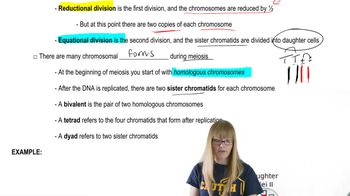Here are the essential concepts you must grasp in order to answer the question correctly.
Meiosis
Meiosis is a specialized form of cell division that reduces the chromosome number by half, resulting in four genetically diverse gametes. It consists of two sequential divisions: meiosis I, where homologous chromosomes are separated, and meiosis II, where sister chromatids are separated. Understanding meiosis is crucial for predicting the genetic outcomes in gametes, especially in organisms like Drosophila.
Recommended video:
Alleles and Genotypes
Alleles are different versions of a gene that can exist at a specific locus on a chromosome. In the context of the question, the Drosophila male carries specific alleles (A₁, B₁, B₂, C₁, C₂, D₁, D₂) that determine its genotype. The combination of alleles present in an organism is referred to as its genotype, which influences its traits and is essential for understanding the genetic variation produced during meiosis.
Recommended video:
New Alleles and Migration
Chromosome Structure and Behavior
Chromosomes consist of DNA and proteins, and during meiosis, they undergo specific behaviors such as alignment and segregation. In Drosophila, the X and Y chromosomes represent sex chromosomes, while the other pairs are autosomes. The arrangement of chromosomes during metaphase I is critical for determining the distribution of alleles into gametes, making it important to visualize and understand chromosome behavior in meiosis.
Recommended video:






